
Cephoidea is a small superfamily within the Symphyta, commonly referred to as stem sawflies, containing some 100 species in 10 genera in the living family, Cephidae, plus another 17 genera in the extinct family Sepulcidae. They first appeared around 212 million years ago in the Norian Age, and are diurnal. Most species occur in the Northern Hemisphere, especially in Eurasia. The larvae are stem borers in various plants, especially grasses, but sometimes other herbaceous plants, shrubs, or trees. A few are pests of cereal grains. They are exceptionally slender for symphytans, often resembling other types of wasps, and they are the only Symphyta which lack cenchri. They are sometimes postulated to be the sister taxon to the Apocrita, though the Orussidae are more commonly considered such.

Tachysphex is a genus of square-headed wasps in the family Crabronidae. There are over 450 described species in Tachysphex.
Karl Vorse Krombein was an American entomologist specializing in Hymenoptera.

Chalcoela iphitalis, the sooty-winged chalcoela, is a moth species of the family Crambidae that occurs throughout North America. They are seen as far south as California, Arizona and South Carolina and as far north as Ontario. Adults can be seen from May to August. The head, body and front portion of the forewings are yellow-orange while the hindwing and back portion of the forewings are grey and silver. The back edge of the hindwing has black spots.
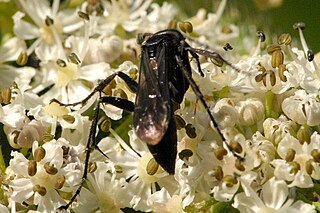
Anoplius nigerrimus is a species of spider wasp, or pompilid, and is the type species of the genus Anoplius.
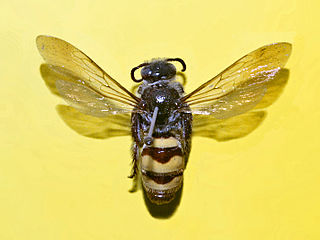
Dielis trifasciata, also known as the three-banded scoliid wasp, is a species in the family Scoliidae.

Tenthredinini are a tribe of sawflies (Hymenoptera), including the family genus Tenthredo.

Empriini is a tribe of sawflies in the family Tenthredinidae.

Brachycistidinae is a subfamily of the flower wasp family Tiphiidae that contains 10 genera and 85 species, and which is confined to the Nearctic zoogeographic region.
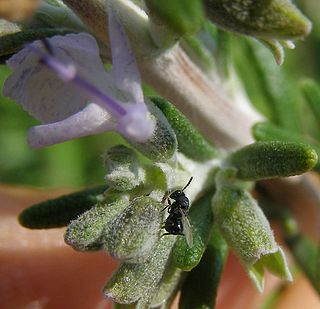
Eurytoma is a genus of parasitoid chalcid wasps in the family Eurytomidae. There are at least 620 described species in Eurytoma.
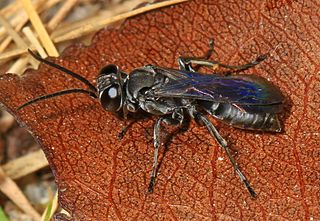
Liris is a genus of solitary, ground-nesting, predaceous wasps, containing over 300 species. Two of its three subgenera, Leptolarra and Motes, are found in North America, with 23 species representing Leptolarra and a single species representing Motes. Liris wasps typically prey on crickets.
Amphibolips gainesi is a species of gall wasp in the family Cynipidae.

Sphex nudus, the katydid wasp, is a species of thread-waisted wasp in the family Sphecidae.
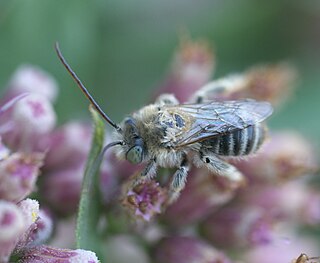
Melissodes is a genus of long-horned bees in the family Apidae. There are 129 described species in Melissodes.

Myzinum is a genus of wasps in the family Thynnidae. There are 63 species presently recognized in Myzinum. They measure 7–24 mm. They parasitize white grubs, including Phyllophaga. They are used as biological controls.

Pteromalus is a genus of pteromalids in the family Pteromalidae. There are at least 430 described species in Pteromalus.

Xorides is a genus of ichneumon wasps in the family Ichneumonidae. There are at least 150 described species in Xorides.
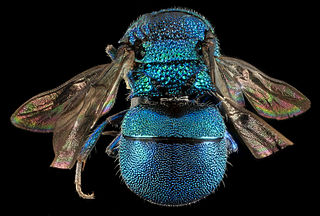
Elampini is a tribe of cuckoo wasps in the family Chrysididae.
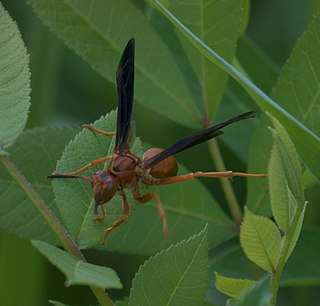
Polistes rubiginosus is one of two species of red paper wasp found in the eastern United States and is noted for the coarser ridges on its propodeum. It is a social wasp in the family Vespidae. Until taxonomic revision by Matthias Buck in 2012, P. rubiginosus was long known under the name P. perplexus. It occurs northernmost from Maryland, Pennsylvania to northern Ohio, south to Florida, and from there west to central Illinois, Kansas, Oklahoma, Texas and Arizona.

Perdita swenki is a species of bee in the family Andrenidae. It is found in North America. It is known to visit: Chrysopsis, Grindelia, Helianthus maximillianii, Liatris, Solidago juncea, and Solidago rigida.

















